Basketball Offense - Kansas Zone Plays
By Dr. James Gels, from the Coach’s Clipboard Basketball PlaybookDisclosure: This page contains affiliate links, which means that Coach's Clipboard receives a small commission (at no cost to you) if you make a purchase using these links.

The 2-3 zone defense is the most commonly used zone defense, designed to stop the inside game. Good outside shooting can beat this zone, but you still need to get the ball inside, especially late in the game, or when your shooters are not hitting. Presented here are notes from Bill Self, Kansas head coach, discussing several plays designed for attacking the zone. Also see "Kansas Zone Offense".
Coach Self has been head men's coach at the University of Kansas since 2003, after coaching at Oral Roberts, Tulsa, and Illinois. His 2008 Kansas team won the NCAA National Championship and he was named coach of the year. Along with his many other accolades, his Kansas teams have been in the NCAA Final Four and Elite Eight a number of times.

Coach Bill Self
Play #1
This play actually start with O5 at the high post. O1 passes to O3 (diagram A) and cuts around O5 and through to the opposite corner. O5 steps out and gets the pass from O3 (diagram B). O5 passes to O2, and O2 passes to O1 in the corner. O5 cuts to the ballside elbow and could get the pass here from O1. If so, O5 looks to pass inside to O4 who seals off the low defender.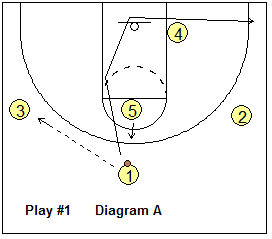
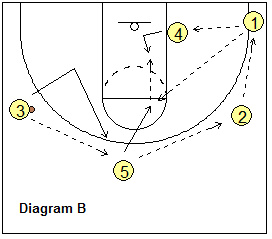
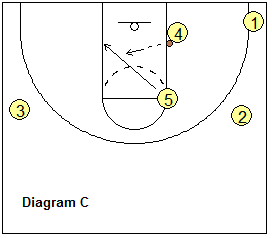
Optionally, O1 could pass to O4 on the block. When this happens, O5 dives across the lane to the weakside block, looking for a pass from O4 and the inside shot (diagram C).
Play #2
O1 dribbles toward the right wing and O2 slides down to the corner and receives the pass there from O1 (diagram A). The outside low zone defender usually comes out to defend O2. Next O2 skip-passes to O3 on the opposite wing (diagram B), and O4 cuts to the ballside elbow and occupies the middle zone defender. The skip-pass to O3 should get the left outside low defender to "lift" (come out to defend O3).
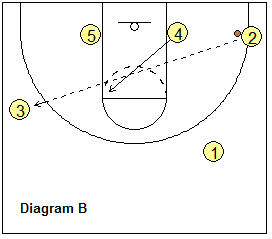
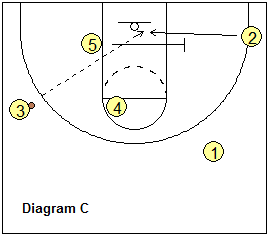
O5 screens the remaining low zone defender who was guarding O2, and O2 cuts around the screen for the pass inside from O3. This could be a weakside lob pass and dunk for big college teams, or a pass to O2 cutting to the ballside block for smaller teams.
Play #3
O1 passes to O2 (diagram A below), and O5 flashes to the ballside elbow, and occupies the middle zone defender. O3 drops inside, getting ready to screen. O2 passes back to O1, as O3 screens the low defender for O4. O4 cuts to the left side for the quick pass from O1. It's important to notice that O1 aligns on left lane line-extended to have a good passing angle.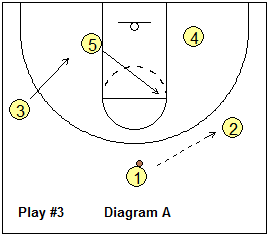

Play #4
O1 passes to O3 and cuts through to the ballside corner (diagram A). O3 passes to O1 in the corner, and this gets the outside low zone defender to come out and guard O1. Meanwhile, O5 screens the middle low defender and O4 cuts to the ballside for the pass from O1 and the lay-up. Optionally, O1 could skip-pass to O2 who is also often open for the 3-point shot.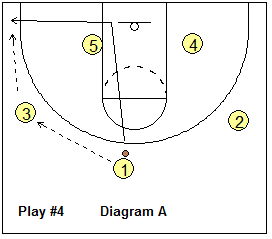
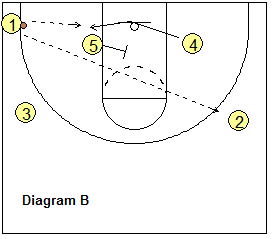
Play #8 ("ATO" - see video below)>/span>
This is a simple, very effective play (see video below). O1 passes to O3 and O1 slides a little to the right wing. O4 screens the X2 defender and O5 screens the inside low X5 defender (diagram 1). O3 takes a dribble right and passes back to O1. O4 slips the screen and cuts down the right lane line for the pass from O1, and a probable lay-up, as O5 has screened off the X5 defender (diagram 2).If the X4 defender drops inside to help (diagram 3), O4 kicks the pass out to O2 for a wide open 3-pointer.

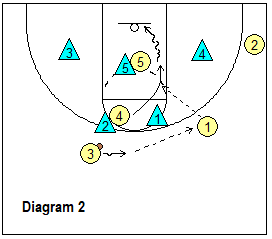
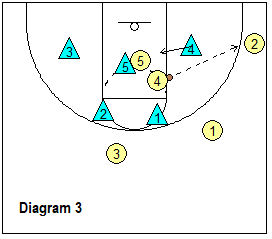
These plays should help you get the ball inside, especially when the outside shots aren't going in. Against the 2-3 zone, you can almost always get 3-point shots, as this is what the zone gives you, and your opponent wants you to shoot from outside. Good teams usually don't settle for outside jump-shots - they mix things up and get the ball inside for high percentage shots and trips to the free-throw line. Getting the ball inside also opens up the outside for better open shots.
Get more Kansas Zone Plays in the Premium Members section or the Playbook download.
It also includes:
- Play #5
- Play #6 (Self calls this the "best zone play ever")
- Play #7
See Coach Bill Self's Zone Offense DVD.
Related pages:
- Kansas Zone Offense
- Zone Offense
- 2-3 Zone Offenses
- 2-3 Zone Plays
- Simple 2-3 Zone Offense
- Stanford Motion-Zone Offense